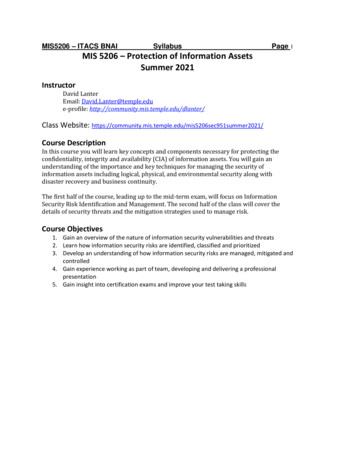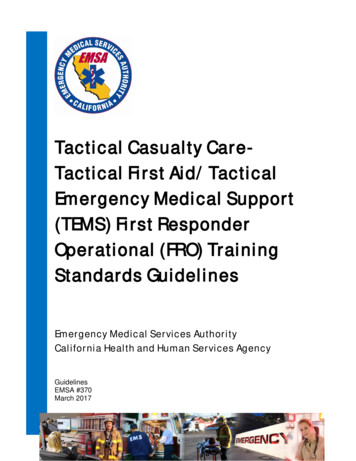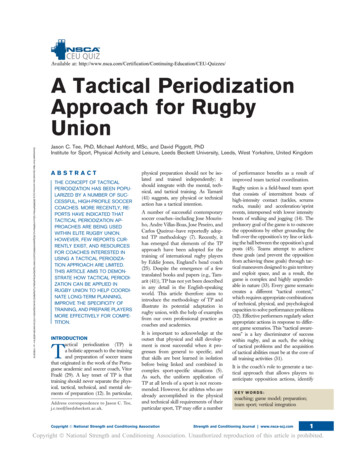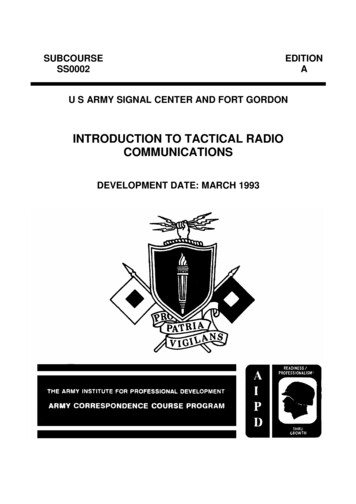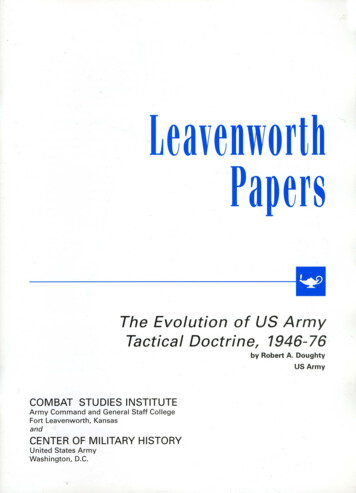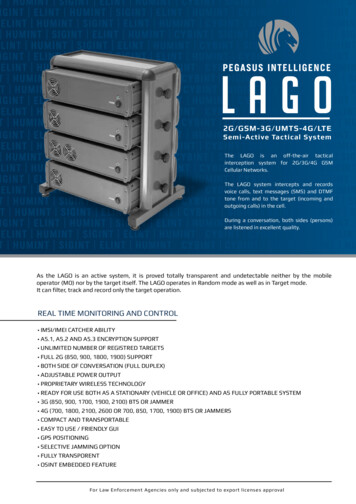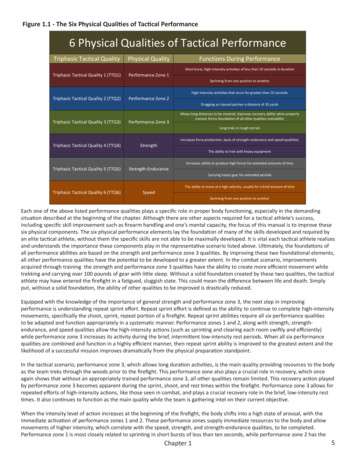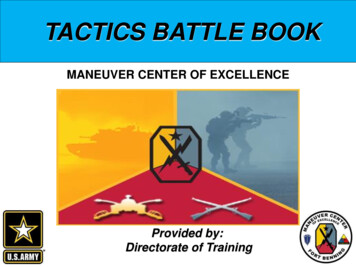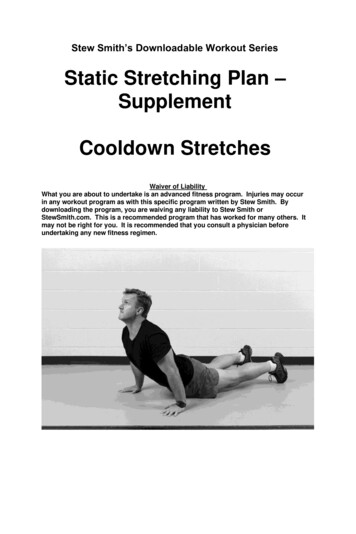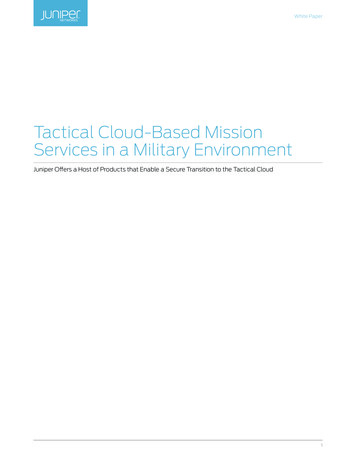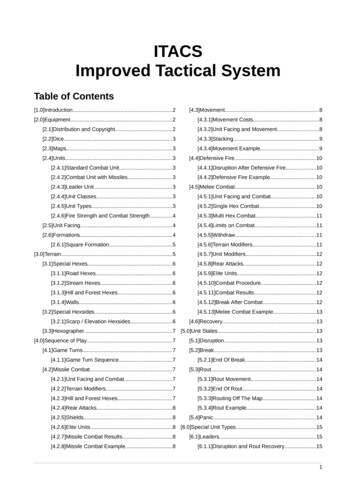
Transcription
ITACSImproved Tactical SystemTable of ipment.2[4.3.1]Movement Costs.8[2.1]Distribution and Copyright.2[4.3.2]Unit Facing and 4.3.4]Movement Example.9[2.4]Units.3[4.4]Defensive Fire.10[2.4.1]Standard Combat Unit.3[4.4.1]Disruption After Defensive Fire.10[2.4.2]Combat Unit with Missiles.3[4.4.2]Defensive Fire Example.10[2.4.3]Leader Unit.3[4.5]Melee Combat.10[2.4.4]Unit Classes.3[4.5.1]Unit Facing and Combat.10[2.4.5]Unit Types.3[4.5.2]Single Hex Combat.10[2.4.6]Fire Strength and Combat Strength.4[4.5.3]Multi Hex Combat.11[2.5]Unit Facing.4[4.5.4]Limits on ]Square Formation.5[4.5.6]Terrain Modifiers.11[3.0]Terrain.5[4.5.7]Unit Modifiers.12[3.1]Special Hexes.6[4.5.8]Rear Attacks.12[3.1.1]Road Hexes.6[4.5.9]Elite Units.12[3.1.2]Stream Hexes.6[4.5.10]Combat Procedure.12[3.1.3]Hill and Forest Hexes.6[4.5.11]Combat Results.12[3.1.4]Walls.6[4.5.12]Break After Combat.12[3.2]Special Hexsides.6[4.5.13]Melee Combat Example.13[3.2.1]Scarp / Elevation Hexsides.6[4.6]Recovery.13[3.3]Hexographer.7 [5.0]Unit States.13[4.0]Sequence of Play.7[5.1]Disruption.13[4.1]Game Turns.7[5.2]Break.13[4.1.1]Game Turn Sequence.7[5.2.1]End Of Break.14[4.2]Missile Combat.7[5.3]Rout.14[4.2.1]Unit Facing and Combat.7[5.3.1]Rout Movement.14[4.2.2]Terrain Modifiers.7[5.3.2]End Of Rout.14[4.2.3]Hill and Forest Hexes.7[5.3.3]Routing Off The Map.14[4.2.4]Rear Attacks.8[5.3.4]Rout e Units.8 [6.0]Special Unit Types.15[4.2.7]Missile Combat Results.8[6.1]Leaders.15[4.2.8]Missile Combat Example.8[6.1.1]Disruption and Rout Recovery.151
[6.1.2]Movement.15[6.9.3]Stacking.18[6.1.3]Melee and Missile Combat.15[6.10]Elite Units.18[6.1.4]Leader Capture, Recovery and Death.15 [7.0]Victory Points.18[6.2]Horse Archers.15[7.1]Panic Level.18[6.3]Feudal Cavalry.16[7.2]Victory.18[6.4]Cavalry Conversion.16 [8.0]Scenarios.18[6.5]Archer Conversion.16 [9.0]Glossary.19[6.6]Throwing Weapons.16 [10.0]Charts and Tables.20[6.7]Fleets.16[10.1]Unit Classes.20[6.7.1]Stacking.16[10.2]Unit Types.21[6.7.2]Carrying Land Units.16[10.2.1]Infantry (A and B).21[6.7.3]Fleet Combat vs Land Units.17[10.2.2]Cavalry (C).21[6.7.4]Land Unit Combat From Fleets.17[10.2.3]Other (D).21[6.7.5]Fleet to Fleet Combat.17[10.2.4]Missile Troops (Ff and Mf).21[6.7.6]Fire Ships.17[10.3]Terrain Chart.22[6.7.7]Combat Effects on Transported Units.17[10.4]Missile Combat Table.25[6.8]Chariots.17[10.5]Melee Combat Table.26[6.9]Elephants.17[10.6]Unit Modifier Table.27[6.9.1]Terrain.18[10.7]Combat Results Table.27[6.9.2]Rampaging.18Game Rules[1.0] IntroductionITACS or Improved Tactical System is a hex-and-counterwargaming system which simulates tactical battles from theearliest times until the end of the 16th Century. It isdesigned to include some of the flexibility of miniaturesstyle games along with the ease of use and faster gameplay of the hex based wargaming world.ITACS has been inspired by various tactical warfare gamescovering the period from ancient to early modern times.ITACS contains a number of rules including the basicmovement and combat rules, terrain effects, leadership,morale, etc. There are also scenarios for ITACS, each ofwhich may contain scenario specific rules that apply only tothat scenario.[2.0] EquipmentITACS is designed to be played online using the VASSALgame system, although players may choose to print outcopies of the counters and maps should they so choose,and play face to face.Game pieces and maps from other tactical games can alsobe used to play ITACS. You may also create your owncounters and maps as well as any number of scenarios touse these maps.All of the maps, game charts, tables, etc, are included inthe VASSAL game file.[2.1] Distribution and CopyrightThe game rules and standard VASSAL module file may befreely distributed under the Creative CommonsAttribution 4.0 International (CC BY 4.0) license. Thislicense may be seen he game images in these rules are for example purposesonly. You may create or adapt your own counters or mapsfor use in this game.You may print copies of the game rules, game counters,and game maps for use in face to face play if you wish. Noroyalties are required for printing the game rules and mapsfor your own use.The game is normally distributed as a ZIP file containing: These rules as a PDF and/or an ODT file; One or more VASSAL vmod files which containthe game, counters, and maps for the scenarios ofthe game; and One or more Hexographer .hxm files which arethe data files used to create the base game maps(stored as PNG files inside the VASSAL module).2
A copy of VASSAL is required to play this game. VASSALcan be downloaded at: http://www.vassalengine.org/ Acopy of VASSAL is not normally distributed along with thisgame.A copy of Hexographer is recommended to be used tocreate maps for this game, by players who wish to createtheir own scenarios. Hexographer may be downloaded (forfree) or a Pro version may be purchased at:http://www.hexographer.com/ A copy of Hexographer is notnormally distributed along with this game.[2.4.2] Combat Unit with MissilesUnits of class Ff and Mf are combat units with missiles.They may move and fire with missiles. Some may alsoattack during melee combat.The game designer is Del (del@babel.com.au).[2.2] DiceMost combats in IPS are resolved using 2 x 6 sided dice.The VASSAL combat engine contains a die roller that issuitable for this.[2.3] MapsEach scenario has one or more maps. There are somecases where the same map is used for many differentscenarios.[2.4.3] Leader UnitLeader units may move, but may neither attack in melee ormissile combat. They do have some special abilities listedin section [6.1].Each map has many different terrain features on it. Themeaning of these terrain features is covered on the TerrainEffects Chart.Each hex on the game maps is intended to representbetween 20 and 200 metres from side to side dependingon the scenario.[2.4] Units[2.4.4] Unit ClassesThere are a number of different units in the game. Unitcounters are of a number of different types, includinginfantry, cavalry, leaders, artillery, etc. Each unit represents The unit class is represented by a letter code at thesomething between 50 and 400 men and horsesbottom of the unit. These are the unit classes in ITACS:depending on the unit type and the scenario.Unit ClassMeaningEach unit has the following characteristics which areincluded on the unit counter.A&BInfantry[2.4.1] Standard Combat UnitCCavalryUnits of class A, B and C are standard combat units. Theymay move, attack, but they may not fire missiles.DOtherELeadersFfMissile InfantryMfMounted Missile TroopsUnit classes have some effect on movement and combat.Unit classes do not affect stacking, formations, or any otherpart of the rules where unit classes are not mentioned.[2.4.5] Unit TypesEach unit has a unit type which is in the top left corner ofthe unit.3
Unit types are used for identification purposes, and insome cases different fleet types can carry other differenttypes of unit.Every unit of the same unit type can be consideredidentical from the point of view of the rules. For examplethere is no difference between any PP unit and any otherPP unit.[2.4.6] Fire Strength and CombatStrengthThe fire strength of a unit is the unit’s attack capability inmissile combat.The combat strength of a unit is the unit’s attack anddefence capability in melee combat.As well as a plain printed combat strength, a unit may havea dot (.) as a combat strength, or it may have a combatstrength listed in brackets like this: [4] A unit with a dot for a combat strength does notadd anything to the combat strength of other unitsstacked in the hex. For this purpose it has acombat strength of zero (0). For example, a stackof 2 PP units and one LB unit has a combatstrength of 12. One or more units with a dot for a combatstrength, when stacked together, have a combatstrength of 1. For example a stack of 3 LB unitshas a combat strength of 1. A unit with a combat strength in brackets [ ] has itsfull combat strength as an attacking unit, but onlyhalf of its combat strength when it is a defendingunit. For example, a HC unit attacks with acombat strength of 4 but defends with a combatstrength of 2.Units without a fire strength have a fire strength of zero (0)and may not attack during the missile combat phase.[2.5] Unit FacingEach unit, when placed on the map faces one hexside.The hex in front of that hexside is the unit’s FRONT hex.There are two adjacent hexes either side of the FRONThex which are considered SIDE hexes. The other 3 hexesadjacent to the unit are considered REAR hexes.An example of unit facing is shown below, showingFRONT, SIDE and REAR hexes.[2.6] FormationsA formation is a number of hexes, each of which isconnected to at least one other hex in the formation, all ofwhich contain units of the same unit type. For example, twoadjacent hexes each containing 2 AX units is oneformation. There are some rules that apply to formationslisted in the game rules below.The following combinations are formations: Two adjacent hexes each containing 2 AX units. Two adjacent hexes., one containing one AX unitand one containing 3 AX units. Two or more adjacent hexes each containing onePS unit and one AX unit.The following combinations are not formations: Two adjacent hexes, one of which contains 2 PSunits and one of which contains 2 LB units. Two hexes each containing 2 PS units, with anempty hex in between.Leaders do not affect formations. A leader unit is notconsidered part of a formation and does not stop multipleadjacent hexes being part of one formation. For example if2 adjacent hexes each contain one PS unit, and one ofthose hexes contains a leader unit but the other hex doesnot, it is still considered one formation.Units in a formation do not have to all have the samefacing.An example of a valid formation is shown below. Each hexcontains one LB and one PS unit.4
Below is not a valid formation because there are two hexescontaining only PS units, and one hex containing only SDunits.The units below are not in a valid formation because thereare empty hexes between the PS unit in 23.04 and theother PS units. The two stacks in 21.05 and 22.06 are avalid formation, however. If an attacking unit or formation suffers an “AD” or“A1X” combat result while attacking a squareformation in melee combat, then the attacking unitmust break. Place a Break marker on theattacking unit and it must make a rout move at theend of the combat phase. A square formation may move 1 and only 1 hexduring each of its movement phases. It may notenter river hexes, any impassable hex, and maynot use road movement or cross bridges.Square formations may only be formed from 4 identicalunits that are not disrupted. For example, 4 PP units mayform a square, but 2 PP units and 2 PS units may not forma square.Square formations may be created from 4 identical unitseven if the stacking limit for the scenario is less than 4.If a square is Disrupted or suffers any unit loss due tomelee or missile combat, then it is no longer a square. The4 (or remaining) units may remain in the hex until their nextmovement phase, at which point they must move to complywith the stacking limits for the scenario (which may be 4 orless than 4).A leader unit may stack in a hex containing a squareformation. That is in addition to the 4 units in the square.More than one square formation in adjacent hexes do notcombine together into a “big” square formation. Each stackof 4 units in one hex is one square formation.[2.6.1] Square FormationIn certain scenarios some unit types (specifically SD, PSand PP units) may form square formation. This is done bymoving 4 units into a single hex, and changing their facingsso that each unit is at 90 degrees to another unit in thesquare. The stack below is an example of squareformation.Square formations have the following advantages andlimits: Units in a square formation defend with the fullstrength of all 4 units in the hex. Units in a square formation may attack any unit inany adjacent hex, but with only the strength of asingle unit. They are not required to attack. Units in a square formation do not have “REAR”hexes and cannot be rear attacked.[3.0] TerrainThe map is comprised of hexes. Each hex contains onetype of terrain, which affects movement and combat in thehex.Each type of terrain has the following effects on the game: Movement Point Cost. This is the cost inmovement points for any unit to enter the hex. Missile Combat Modifier: This number is added tothe missile combat dice roll when the unit in thehex is attacked by missile combat troops. This isoften a negative number, meaning that the diceroll is reduced. Melee Combat Modifier: This number is added tothe melee combat dice roll with the unit in the hexis attacked by units in an adjacent hex during themelee combat phase. This is often a negativenumber. Notes: Any special notes about the terrain.The standard game terrain is described in the Terrain Chartin section [10.3].5
[3.1] Special Hexesa wall hex only from the direction where there are noelevation hexsides.[3.1.1] Road HexesWall hexes have a stacking limit of 1 unit per hexregardless of the stacking limit of the scenario. Onlyinfantry units (class A, B, Ff) and leaders (class E) mayenter wall hexes, entry or movement by cavalry (class C,Mf) is not permitted.Road hexes are hexes that contain a road running throughthe hex. A unit moving along a road pays only 1 movementpoint per hex, regardless of the background terrain in thehex.For example, the MS unit in hex 26.29 below can move 3hexes to hex 29.28 along the road. This is despite that theswamp and marsh hexes are each 3 movement points toenter.Units may attack enemy units on a wall hex during meleecombat only if the attacking units are on a siege tower orladder, or on an adjacent wall hex. Similarly, units on awall hex may not attack units in adjacent hexes unlessthose defending units are on a siege tower or ladder, or onan adjacent wall hex.The melee terrain modifier of the wall hex (-6) does notapply if the attacking units are on an adjacent wall hex. Itonly applies if the attacking units are on a ladder or siegetower.Road hexes do not affect the missile or melee combatmodifiers of the underlying hex.[3.1.2] Stream HexesStreams are a special type of terrain that runs throughexisting terrain. For example the following shows a streamrunning through a clear terrain hex.Stream hexes cost 1 extra movement point to enter, inaddition to the movement cost of the background terrain.For example as shown, the stream hexes in clear terrainhexes each cost 2 movement points to enter.Streams have a melee combat modifier and a missilecombat modifier that are added to the modifiers for thebackground terrain. For example the above hexes have amissile combat modifier of 2, adding 2 for the streamand 0 for the clear terrain hex.[3.1.3] Hill and Forest HexesHill, Forest, Jungle, Forest Hills and Jungle Hill hexes havespecial effects on missile combat, as described in section[4.2.3].[3.1.4] Walls[3.2] Special HexsidesSome hexsides also affect unit movement and combat asfollows.[3.2.1] Scarp / Elevation HexsidesAn example scarp hexside is shown below.Scarp hexsides have an “up” direction and a “down”direction. The “down” direction is in the direction that thehashes are pointing. For example, from hex 20.20 to hex20.19 is a “down” direction.Movement in either the up or down direction is notpermitted. Melee combat in either the up direction or thedown direction is not permitted.Missile combat gains a 2 missile combat modifier whenfiring from the “up” side to the “down” side. For example aunit firing from hex 20.20 to hex 20.18 would have a 2missile combat modifier. The modifier is -4 from the downside to the up side. These are in addition to any missilecombat modifiers of the target hex. For example, a unitfiring from 20.18 to 20.20 would have a -8 combat modifier– -4 for the scarp hexside and -4 for the grassy hills hex.Walls are present in certain scenarios. Wall hexes areshown with elevation hexsides to show the direction thatthe wall can be entered from (if any). Units may move onto6
[3.3] Hexographer[4.2.1] Unit Facing and CombatI have used the Hexographer program (available athttp://www.hexographer.com/) to build the terrain for themaps included in the standard game file. This is a customapplication designed for building game maps. It contains awide variety of map terrain types and symbols.Each unit, when placed on the map faces one hexside.The hex in front of that hexside is the unit’s FRONT hex.There are two adjacent hexes either side of the FRONThex which are considered SIDE hexes. The other 3 hexesadjacent to the unit are considered REAR hexes.I have no association with the developers of Hexographerbut I recommend purchasing a copy of this program if youplan on building maps or scenarios for ITACS.During missile combat a unit may attack through any of itsFRONT or SIDE hexes with the exception of certain unittypes as described in the scenario, or in the rules onspecial unit types.[4.0] Sequence of Play[4.2.2] Terrain Modifiers[4.1] Game TurnsDepending on the terrain that the defending units are in,there may be a modifier to the missile combat. This isshown on the Terrain Chart in section [10.3]. This terrainmodifier is added to the dice roll in missile combat. Thisterrain modifier is often a negative number, which willreduce the dice roll number.Each game is played in multiple game turns. Each playertakes turns in playing one game turn. During the player’sgame turn they may take each of the actions listed in theirgame turn, one at a time, until the last action is reached.The first player is the player listed in the scenario to movefirst. That player plays the first game turn, and then thesecond player plays the second game turn, and so on.Each player takes turns in alternating game turns untileach player has played the maximum number of gameturns allowed by the scenario.You can use an on-map marker to indicate which gameturn number is currently being played. Another markerindicates the maximum number of game turns that can beplayed.[4.2.3] Hill and Forest HexesHexes containing Hill, Forest, Grassy Hill, Forest Hill orJungle Hill hexes block line of sight for troops firing inmissile combat.A missile combat unit may attack into one of these hexesbut not through one of these hexes. In the example below,neither the LB unit in hex 27.15 nor the CB unit in hex24.17 can fire on each other, because of the intervening hillhex 26.16.Once both players have each played one game turn, thegame turn number is increased by one.During a player’s game turn the player is referred to as the“attacker” and the opponent is referred to as the“defender”.[4.1.1] Game Turn SequenceDuring each player’s game turn they take the followingactions, in this order:1.Missile Combat2.Movement3.Defensive Fire4.Melee Combat5.RecoveryEach of these actions is described in detail in the followingsections.Additionally, units that are on Hill, Forest Hill, Grassy Hill orJungle Hill hexes may add 1 to their fire range, when firingon units that are not on one of these hexes and there is nointervening hex that blocks line of sight. In the examplebelow, the LB unit may fire missiles at the CB unit eventhough it is 4 hexes away, because the LB unit has a 1fire range due to being on a Grassy Hill hex. The CB unitmay not fire at the LB unit because the CB unit is is in aMud hex and it has a range of 3.[4.2] Missile CombatEach of the attacker’s combat units with missiles mayattack one hex within their fire range. All units that arefiring on the same hex have their fire strength addedtogether to resolve the combat – no hex may be attackedmore than once each player turn by missiles and there isno limit to the number of missile combat units that canattack one hex. No unit may attack units in more than onehex.7
[4.2.4] Rear AttacksUnits being attacked through rear hexes (where a straightline from the centre of the firing unit to the centre of the unitbeing attacked passes through a rear hex) adds a 1 diceroll modifier for missile combat.If there is more than one missile unit attacking, then the 1dice roll modifier applies if any of those units are attackingthrough a rear hex.[4.2.5] ShieldsIn most scenarios SD units and in some scenarios otherunit types have shields. This gives a -2 dice roll modifier ifthe unit is not being attacked through a rear hex.The total modifier is -1 2 -1 -1 -1Two dice are rolled, with numbers 5 and 2. The total is 7.To that we add the total modifier (-1) and the final result is6.We check on the Missile Combat Table and the combatresult for a roll of 6 is DD.Checking the Combat Results Table we find the result “Thedefender is disrupted by the combat. Place two D markerson top of the units in the defending hex.”. So we place twoD markers on top of the stack of MS units and the missilecombat is finished. The MS units are disrupted. Note thatthe effects of disruption are covered in section [5.1].[4.2.6] Elite UnitsIn certain scenarios some units are indicated as Elite units.Elite units affect missile combat in the following ways: Elite units add 2 to the dice roll when attacking inmissile combat. Elite units do not affect the dice roll when beingattacked in missile combat.[4.2.7] Missile Combat ResultsTo resolve missile combat, the following procedure isfollowed: Add together the fire strength of all units that areattacking. Calculate the range from the hex that is beingattacked to the most distant unit that is firing (theunit that is the most number of hexes away fromthe target hex). Calculate any modifiers due to defending unittype, terrain, stacking, etc.Roll two dice and consult the Missile CombatTable in section [10.4] of the rules.The possible combat results for missile combat are shownin the Combat Results Table in section [10.7] of the rules.[4.2.8] Missile Combat ExampleIn the example below, the two LB units are attacking thehex containing the two MS units advancing down the road.Consulting the Terrain Chart and the Missile Combat Tablewe find the following dice roll modifiers: Attacking Fire Strength (6): -1. Terrain Missile Combat Modifier (Mud): 2 Stacking (2 units): -1 Range (2 hexes): -1 The MS units do not have a shield modifier andthe LB units are not elite so there are no othermodifiers. Neither LB unit is attacking the hexfrom the rear, so there is no modifier for that.[4.3] MovementDuring the movement action the attacker may move any orall of their units. A player is not required to move any unitsin their movement phase, or may choose to move some butnot all of their units.[4.3.1] Movement CostsEach unit has a number of movement points. The unit mayuse up to but not more than the number of movementpoints that the unit has. For example, a SD unit has 4movement points.Each hex costs a number of movement points to enter. Forexample a clear terrain or farmland hex costs 1 movementpoint to enter the hex. All of the movement costs arestated on the terrain chart, and there may be movementpoint costs for different hex types for each scenario.A unit may not enter a hex where the movement costsexceed the number of movement points that the unit hasremaining. For example a SD unit that has moved through3 clear terrain hexes (each costing 1 movement point) maynot then enter a forest hex (2 movement points).A unit does not have to spend all of its movement pointswhen moving.[4.3.2] Unit Facing and MovementEach unit, when placed on the map faces one hexside.The hex in front of that hexside is the unit’s FRONT hex.There are two adjacent hexes either side of the FRONThex which are considered SIDE hexes. The other 3 hexesadjacent to the unit are considered REAR hexes.To enter a hex, a unit may enter the FRONT hex or eitherof the SIDE hexes. When doing so the unit may choose toturn its facing to face the hex that it is entering. That will8
create a new FRONT and 2 new SIDE hexes which can beentered.Before or after moving into a hex the unit may turn in placeto face any other hexside. Doing a change of face costs aunit 1 movement point.[4.3.3] StackingEach scenario has a stacking limit defined for the scenario(which may be different for each side), however by defaultup to 3 units may stack in each hex, except in the case ofsquare formations which may contain 4 units.Leader units (class E) are separate from stacking. Theycan stack in a hex in addition to the 3 or 4 other units in thehex.Some terrain types have a lower stacking limit
ITACS or Improved Tactical System is a hex-and-counter wargaming system which simulates tactical battles from the earliest times until the end of the 16th Century. It is designed to include some of the flexibility of miniatures style games along with the ease of use and faster game play of the hex based wargaming world.
